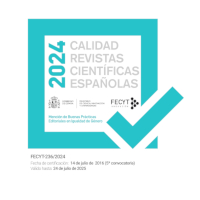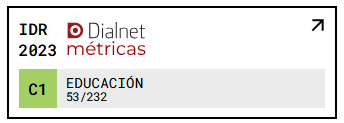Colors, forms and stains of the school from the everyday aesthetic experience
DOI:
https://doi.org/10.18172/con.3136Keywords:
Aesthetic quality, educational environments, visual voiceAbstract
This research is part of the project “A study of the aesthetic quality of three Valencian schools” and brings us closer to the learner figure who likes the school, appreciating its surroundings from the everyday aesthetic experience. In relation to the identity bonds established with the educational center, the intention is determine the emotions associated with this context, in order to collect the determinants of aesthetic quality from the student point of view. The study is developed thanks to the participation of 332 students from three public schools. What is used during the data collection phase, is the ‘Visual Arts Based Educational’, through photo-elicitations and pictorial interventions; And the ‘Image Based Research’, during the analysis phase. The results are articulated according to three thematic categories: intervened elements, shape and color of the shape. It concludes with the reasons why educational policies should be concerned with the aesthetic quality of schools and the care of the constituent elements of the educational environment such as continents, contents and environmental factors.
Downloads
References
Alonso-Sanz, A. (2016a). Creatividad en el diseño de instrumentos de recogida de datos. Las preferencias espaciales experimentadas por escolares. Arte y Políticas de Identidad, 14, 19-40. Recuperado de http://revistas.um.es/api/article/view/280441/205051.
Alonso-Sanz, A. (2016b). Factores estéticos determinantes de la calidad y el confort en el aula infantil. Revista Electrónica Interuniversitaria de Formación del Profesorado, 19(3), 53-65. http://doi.org/10.6018/reifop.19.3.267241.
Alonso-Sanz, A. (2016c). La experiencia corporal de los escolares para la calidad estética de los centros educativos. MeTis Mondi educativi. Temi indagini suggestioni, 2. Recuperado de http://www.metis.progedit.com/anno-vi-numero-2-122016-cornici-dai-bordi-taglienti/198-buone-prassi/917-la-experiencia-corporal-de-los-escolares-para-la-calidad-estetica-de-los-centros-educativos.html.
Alonso-Sanz, A. y Zariquiey, B. (2016). Las emociones que habitan la escuela para la calidad estética. Tecnología en las Aulas, 27. Recuperado de https://www.interempresas.net/Tecnologia-aulas/Articulos/165778-Las-emociones-que-habitan-la-escuela-para-la-calidad-estetica.html.
Alonso-Sanz, A. (2017a). Repensando tres entornos educativos consolidados. Artseduca, 18, 79-99. Recuperado de http://www.e-revistes.uji.es/index.php/artseduca/article/view/2651/2181.
Alonso-Sanz, A. (2017b). Escuelas: espacios equivocados frente a los deseados por escolares. Revista Electrónica Actualidades Investigativas en Educación, 17(3), 1-33. Recuperado de https://revistas.ucr.ac.cr/index.php/aie/article/view/29824/29851.
Alonso-Sanz, A. (2018). Preferencias estéticas en los recorridos escolares: dibujos que dan voz. Matéria-Prima, 6(1), 18-26.
Alschuler, R. y LaBerta H. (1947). Painting and Personality-A Study of Young Children. Chicago: University of Chicago Press.
Auge, M. (2000). Los “no lugares” espacios del anonimato. Una antropología de la Sobremodernidad. Barcelona: Gedisa. (Edic. orig. en francés, 1992).
Arellano Hernández, A. (2014). Epistemología antropológica como conocimiento del hombre: El papel de la antropología de la tecnociencia. Acta sociológica, 63, 15-39. https://doi.org/10.1016/S0186-6028(14)70474-8.
Burke, C., Gallagher, C., Prosser, J. y Torrington. J. (2006). The view of the child: Explorations of the visual culture of the made environment. En Economic and Social Science Research Council (ESRC) Conference on Pupil Voice, Nottingham, UK.
Burke, C. (2007). The View of the Child: Releasing “visual voices” in the design of learning environments. Discourse: studies in the cultural politics of education, 28(3), 359-372. http://doi.org/10.1080/01596300701458947.
Dewey, J. (2008). El arte como experiencia. Barcelona: Paidós Ibérica.
Errázuriz-Larraín, L. H. (2015a). Calidad estética del entorno escolar: el (f)actor invisible. Arte, Individuo y Sociedad, 27(1), 81-100. http://doi.org/10.5209/rev_ARIS.2015.v27.n1.43861.
Errázuriz-Larraín, L. H. (Editor), (2015b). El (f)actor invisible. Santiago de Chile: Consejo Nacional de la Cultura y las Artes.
Fischman, J. E. (2006). Las fotos escolares como analizadores en la investigación educativa. Educação & Realidade, 31(2), 79-94. Recuperado de http://www.redalyc.org/articulo.oa?id=317227044006.
Fontal, O. (Coord.) (2013). La educación patrimonial. Del patrimonio a las personas. Gijón: Trea.
García, P. (2000). Notas críticas sobre el aprendizaje estético. Contextos educativos, 3, 283-296. http://doi.org/10.18172/con.426.
Gutiérrez, J. (2009). Estándares básicos para construcciones escolares, una mirada crítica. Revista de Educación y Pedagogía, 21(54), 155-176. Recuperado de http://aprendeenlinea.udea.edu.co/revistas/index.php/revistaeyp/article/view/9786/8994.
González, D. (2015). Apuntes de lectura sobre estética cotidiana y cultura visual. En L. Errázuriz-Larraín (Ed.), El (f)actor invisible. Estética cotidiana y cultura visual en espacios escolares, (pp. 193-209). Santiago de Chile: Consejo Nacional de la Cultura y las Artes.
Hernández, F. (2012). La cultura visual como estrategia que posibilita aprender a partir de establecer relaciones. Instrumento, 14(2), 195-207.
Huerta, R. (2015). La ciudad y sus docentes. Miradas desde el arte y la educación. Barcelona: UOC.
Light, A. y Smith, J. (2005). The Aesthetic of Every Day Life. Nueva York: Columbia University Press.
Lipponen, L., Rajala, A., Hilppö, J. y Paananen, M. (2015). Exploring the foundations of visual methods used in research with children. European Early Childhood Education Research Journal, 24(6), 936-946. http://doi.org/10.1080/1350293X.2015.1062663.
Mandoki, K. (1994). Prosaica, Introducción a la Estética de lo Cotidiano. México: Editorial Grijalbo.
Marín, R. (2005). La “Investigación Educativa Basada en las Artes Visuales” o “Arteinvestigación educativa”. En R. Marín (Ed.), Investigación en Educación Artística, (pp. 223-274). Granada: Universidad de Granada.
Marín, R. y Roldán, J. (2008). Imágenes de las miradas en el museo. Un fotoensayo descriptivo-interpretativo a partir de H. Daumier. En R. de la Calle y R. Huerta (Eds.), Mentes Sensibles. Investigar en Educación y Museos, (pp. 97-108). València: Publicacions de la Universitat de València.
Marín, R. y Roldán, J. (2009). Proyecciones, tatuajes y otras intervenciones en las obras del museo (Un fotoensayo a partir de T. Struth). Arte, Individuo y Sociedad, 21, 99-106.
Marín, R. y Roldán, J. (2010). Photo essays and photographs in visual arts-based educational research. International Journal of Education through Art, 6(1), 7-23. http://dx.doi.org/10.1080/10.1386/eta.6.1.7_1.
Palacios, A. (2011). La comprensión del entorno construido desde la educación artística. Una propuesta para educación primaria y formación inicial del profesorado. (Tesis Doctoral, Facultad de Bellas Artes, Universidad Complutense de Madrid).
Saito, Y. (2007). Everyday Aesthetic. Nueva York: Oxford University Press.
Downloads
Published
How to Cite
Issue
Section
License
The authors retain copyright of articles and authorize Contextos Educativos. Revista de Educación the first publication. They are free to share and redistribute the article without obtaining permission from the publisher as long as they give appropriate credit to the editor and the journal.
Self-archiving is allowed too. In fact, it is recommendable to deposit a PDF version of the paper in academic and/or institutional repositories.












